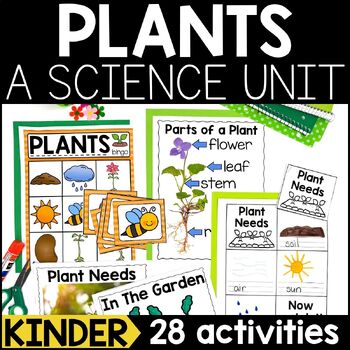Plants: A Science Unit | Plant Life Cycle | Parts of a Plant | Plants Activities
- Zip
What educators are saying
Also included in
- Engage your class in exciting hands-on learning experiences all year long with this Kindergarten Science Bundle. This kindergarten science curriculum resource contains 52 week-long science units and 12 months worth of seasonal/holiday science experiments. This bundle is packed with activities and inPrice $120.00Original Price $620.89Save $500.89
- Engage your class in exciting hands-on learning experiences with this Kindergarten Life Science Bundle. This kindergarten science curriculum resource contains 13 standalone life science units. Each unit is packed with activities and includes PowerPoint lessons, student activity pages, nonfiction emePrice $78.40Original Price $169.00Save $90.60
Description
Engage your class in an exciting hands-on experience learning all about plants! Students will learn about the needs of plants, parts of a plant, and the plant life cycle. This science unit has over 250 pages of material that you and your students will love! This activity packed unit includes 3 PowerPoint Lessons, lots of engaging posters rich with vocabulary, student worksheets, crafts, writing activities, and much more!
This resource is perfect for science in Kindergarten, First Grade, and Second Grade classrooms and packed full of inviting science activities.
With this unit you’ll have everything you need and more to make this your most exciting science topic of the year. Click on “View Preview” for a closer look at what you'll get.
THIS PLANTS UNIT IS INCLUDED IN OUR:
WHAT'S INCLUDED:
- Unit Overview & Teacher Guide
- Complete Week of Lesson Plans
- At Home Letter
- Science Center Instructions
- Science Questions / Science Talk
- Book, Video, and Song Lists
- Plants Introductory PowerPoint Lesson
- Plant Needs PowerPoint Lesson
- Parts of a Plant PowerPoint Lesson
- Plants Posters
- Plant House Activity
- Question of the Week
- Plant Needs Posters
- Plants Needs Experiment
- Plant Needs Mini Book
- Parts of a Plant Posters
- Parts of a Plant Worksheets
- Plant Life Cycle Posters
- Plant Life Cycle Worksheet
- Plant Craftivity
BONUS MATERIALS:
- Writing Center
- Definition Posters
- Word Wall
- Circle Map
- In my Garden Emergent Reader
- I Can Plant Emergent Reader
- In the Garden Emergent Reader
- Plant Needs Emergent Reader
- Fingerplay
- Plants BINGO
- How to Grow a Plant Sequencing
- I Can Eat a Whole Plant Worksheet
- My Bag of Plants Printable
- Sensory Bin
- Plant Person Craft
- Plants Can-Have-Are
- Plants STEM Activity
- Plant Life Cycle Hat
WAYS TO USE THIS UNIT
- Use each of the 3 PowerPoints as a daily mini-lesson. Gather your students for a quick, whole group lesson to kick off each day of learning. Each lesson is colorful and inviting, with simple text perfect for your growing readers.
- Students will love completing the crafts, labeling activities, and cut/paste worksheets. Try incorporating these and other activities from this unit in a science center. Your students will have so much fun collaborating with their friends while learning all about plants.
- This unit is filled with student activity pages. Use the many printables and emergent readers for independent work or partner practice. Not enough time during your science block? We get that! Create cross curricular connections when you incorporate the student worksheets and booklets in your reading and writing centers.
- Provide closure to each day's learning by using the songs and videos that are linked in this product. You won’t ever have to go searching for fun ways to engage your students when learning about plants when you use this unit!
WHAT TEACHERS ARE SAYING:
⭐⭐⭐⭐⭐”We used many of the items in this resource to review and reteach plant parts and plant life cycle. The photos used in the resources are beautiful! There are plenty of whole group, small group, and individual activities included."
⭐⭐⭐⭐⭐"The pictures were fantastic and the kids loved that they were able to take the pictures and compare them to the real life items I showed them. They also LOVED the flower pot activity and really showed they understood when they drew on the fronts of the pots. It really helped build their confidence in being able to do tasks, while we did the gluing as a class."
⭐⭐⭐⭐⭐ "Again, these units are absolute favorites of both mine and my students! Many resources and activities and very engaging. Thank you!"
CHECK OUT THESE RELATED PRODUCTS:
LET’S CONNECT
➡️Subscribe to our weekly newsletter where you'll receive freebies and be the first to know about sales and new products.
If you have any questions or need help, please email us at hello@adabofgluewilldo.com.
Copyright © A Dab of Glue Will Do, LLC







